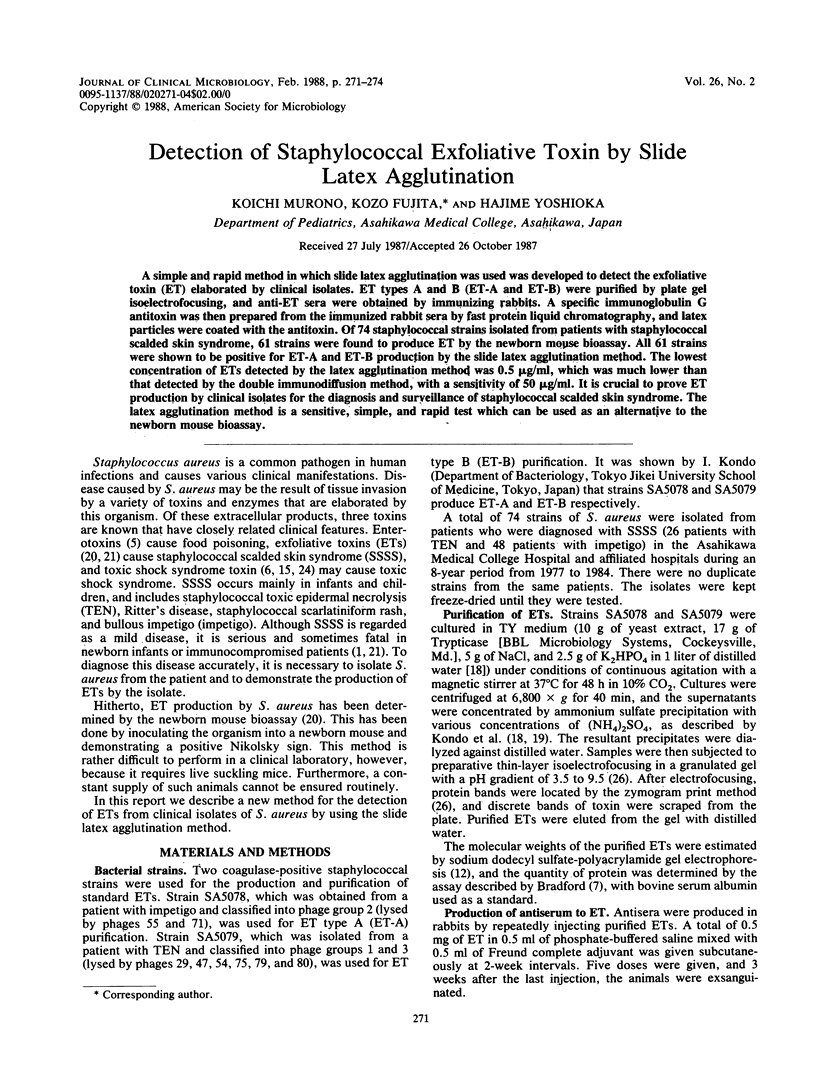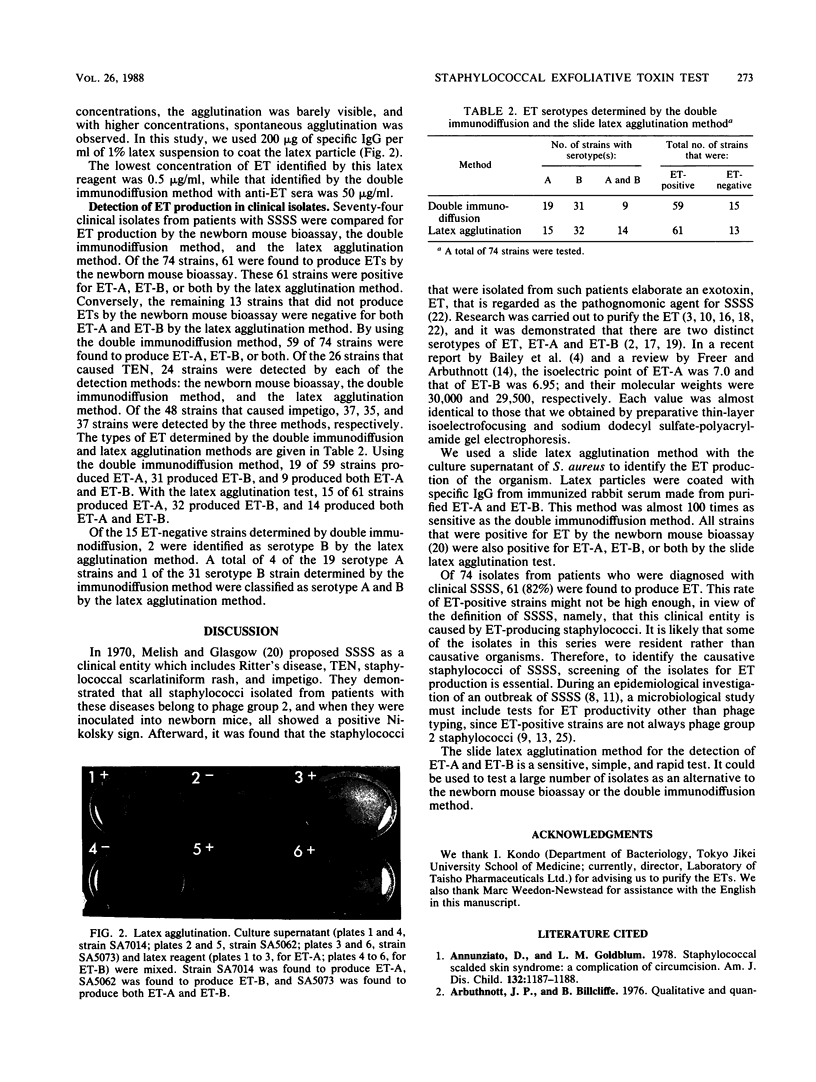Abstract
A simple and rapid method in which slide latex agglutination was used was developed to detect the exfoliative toxin (ET) elaborated by clinical isolates. ET types A and B (ET-A and ET-B) were purified by plate gel isoelectrofocusing, and anti-ET sera were obtained by immunizing rabbits. A specific immunoglobulin G antitoxin was then prepared from the immunized rabbit sera by fast protein liquid chromatography, and latex particles were coated with the antitoxin. Of 74 staphylococcal strains isolated from patients with staphylococcal scalded skin syndrome, 61 strains were found to produce ET by the newborn mouse bioassay. All 61 strains were shown to be positive for ET-A and ET-B production by the slide latex agglutination method. The lowest concentration of ETs detected by the latex agglutination method was 0.5 microgram/ml, which was much lower than that detected by the double immunodiffusion method, with a sensitivity of 50 micrograms/ml. It is crucial to prove ET production by clinical isolates for the diagnosis and surveillance of staphylococcal scalded skin syndrome. The latex agglutination method is a sensitive, simple, and rapid test which can be used as an alternative to the newborn mouse bioassay.
Full text
PDF



Images in this article
Selected References
These references are in PubMed. This may not be the complete list of references from this article.
- Annunziato D., Goldblum L. M. Staphylococcal scalded skin syndrome. A complication of circumcision. Am J Dis Child. 1978 Dec;132(12):1187–1188. doi: 10.1001/archpedi.1978.02120370035008. [DOI] [PubMed] [Google Scholar]
- Arbuthnott J. P., Billcliffe B., Thompson W. D. Isoelectric focusing studies of staphylococcal epidermolytic toxin. FEBS Lett. 1974 Sep 15;46(1):92–95. doi: 10.1016/0014-5793(74)80342-x. [DOI] [PubMed] [Google Scholar]
- Bailey C. J., de Azavedo J., Arbuthnott J. P. A comparative study of two serotypes of epidermolytic toxin from Staphylococcus aureus. Biochim Biophys Acta. 1980 Jul 24;624(1):111–120. doi: 10.1016/0005-2795(80)90230-5. [DOI] [PubMed] [Google Scholar]
- Bonventre P. F., Weckbach L., Staneck J., Schlievert P. M., Thompson M. Production of staphylococcal enterotoxin F and pyrogenic exotoxin C by Staphylococcus aureus isolates from toxic shock syndrome-associated sources. Infect Immun. 1983 Jun;40(3):1023–1029. doi: 10.1128/iai.40.3.1023-1029.1983. [DOI] [PMC free article] [PubMed] [Google Scholar]
- Bradford M. M. A rapid and sensitive method for the quantitation of microgram quantities of protein utilizing the principle of protein-dye binding. Anal Biochem. 1976 May 7;72:248–254. doi: 10.1006/abio.1976.9999. [DOI] [PubMed] [Google Scholar]
- Curran J. P., Al-Salihi F. L. Neonatal staphylococcal scalded skin syndrome: massive outbreak due to an unusual phage type. Pediatrics. 1980 Aug;66(2):285–290. [PubMed] [Google Scholar]
- Dimond R. L., Wuepper K. D. Purification and characterization of a staphylococcal epidermolytic toxin. Infect Immun. 1976 Feb;13(2):627–633. doi: 10.1128/iai.13.2.627-633.1976. [DOI] [PMC free article] [PubMed] [Google Scholar]
- Dowsett E. G., Petts D. N., Baker S. L., DeSaxe M. J., Coe A. E., Naidoo J., Noble W. C. Analysis of an outbreak of staphylococcal scalded skin syndrome: strategies for typing 'non-typable' strains. J Hosp Infect. 1984 Dec;5(4):391–397. doi: 10.1016/0195-6701(84)90007-0. [DOI] [PubMed] [Google Scholar]
- Florman A. L., Holzman R. S. Nosocomial scalded skin syndrome. Ritter's disease caused by phage group 3 Staphylococcus aureus. Am J Dis Child. 1980 Nov;134(11):1043–1045. [PubMed] [Google Scholar]
- Freer J. H., Arbuthnott J. P. Toxins of Staphylococcus aureus. Pharmacol Ther. 1982;19(1):55–106. doi: 10.1016/0163-7258(82)90042-0. [DOI] [PubMed] [Google Scholar]
- Igarashi H., Fujikawa H., Usami H., Kawabata S., Morita T. Purification and characterization of Staphylococcus aureus FRI 1169 and 587 toxic shock syndrome exotoxins. Infect Immun. 1984 Apr;44(1):175–181. doi: 10.1128/iai.44.1.175-181.1984. [DOI] [PMC free article] [PubMed] [Google Scholar]
- Johnson A. D., Metzger J. F., Spero L. Production, purification, and chemical characterization of Staphylococcus aureus exfoliative toxin. Infect Immun. 1975 Nov;12(5):1206–1210. doi: 10.1128/iai.12.5.1206-1210.1975. [DOI] [PMC free article] [PubMed] [Google Scholar]
- Johnson A. D., Spero L., Cades J. S., de Cicco B. T. Purification and characterization of different types of exfoliative toxin from Staphylococcus aureus. Infect Immun. 1979 Jun;24(3):679–684. doi: 10.1128/iai.24.3.679-684.1979. [DOI] [PMC free article] [PubMed] [Google Scholar]
- Kondo I., Sakurai S., Sarai Y. New type of exfoliatin obtained from staphylococcal strains, belonging to phage groups other than group II, isolated from patients with impetigo and Ritter's disease. Infect Immun. 1974 Oct;10(4):851–861. doi: 10.1128/iai.10.4.851-861.1974. [DOI] [PMC free article] [PubMed] [Google Scholar]
- Kondo I., Sakurai S., Sarai Y. Purification of exfoliatin produced by Staphylococcus aureus of bacteriophage group 2 and its physicochemical properties. Infect Immun. 1973 Aug;8(2):156–164. doi: 10.1128/iai.8.2.156-164.1973. [DOI] [PMC free article] [PubMed] [Google Scholar]
- Melish M. E., Glasgow L. A. Staphylococcal scalded skin syndrome: the expanded clinical syndrome. J Pediatr. 1971 Jun;78(6):958–967. doi: 10.1016/s0022-3476(71)80425-0. [DOI] [PubMed] [Google Scholar]
- Melish M. E., Glasgow L. A. The staphylococcal scalded-skin syndrome. N Engl J Med. 1970 May 14;282(20):1114–1119. doi: 10.1056/NEJM197005142822002. [DOI] [PubMed] [Google Scholar]
- Melish M. E., Glasgow L. A., Turner M. D. The staphylococcal scalded-skin syndrome: isolation and partial characterization of the exfoliative toxin. J Infect Dis. 1972 Feb;125(2):129–140. doi: 10.1093/infdis/125.2.129. [DOI] [PubMed] [Google Scholar]
- Reiser R. F., Robbins R. N., Khoe G. P., Bergdoll M. S. Purification and some physicochemical properties of toxic-shock toxin. Biochemistry. 1983 Aug 2;22(16):3907–3912. doi: 10.1021/bi00285a028. [DOI] [PubMed] [Google Scholar]
- Sarai Y., Nakahara H., Ishikawa T., Kondo I., Futaki S. A bacteriological study on children with staphylococcal toxic epidermal necrolysis in Japan. Dermatologica. 1977;154(3):161–167. doi: 10.1159/000251125. [DOI] [PubMed] [Google Scholar]
- de Azavedo J., Arbuthnott J. P. Prevalence of epidermolytic toxin in clinical isolates of Staphylococcus aureus. J Med Microbiol. 1981 Aug;14(3):341–344. doi: 10.1099/00222615-14-3-341. [DOI] [PubMed] [Google Scholar]



